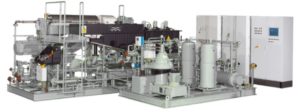Alfa Laval Pheonix
The modular Alfa Laval Phoenix system enables owners or operators of virtually any type of drilling rig or offshore service vessel to boost the company’s environmental profile as well as achieve significant reductions in operating costs for water treatment and disposal.
New solution to old problems
Offshore rigs and production platforms – as well as other installations and vessels used in the oil and gas industry – operate with complex mixtures of oil, water and solids, often in large volumes. These drains have to be treated so the water rejected overboard complies with stringent environmental legislation, including International Maritime Organization (IMO) standards. A treatment onshore requires costly transport and storage tanks that take up precious space on the rigs.
Variations in waste streams
These complex streams of contaminated water vary considerably in composition and physical properties. However, they almost always contain both hydrocarbon residues and solid particles – ranging from coarse to extremely fine. These mixtures are often in the form of complex emulsions that are difficult for traditional separation systems to tackle.
Treatment at source – the benefits
The Alfa Laval Phoenix system means
- One single system for treating all kinds of contaminated water.
- Ideal combination of mechanical and chemical separation technologies.
- Much less need for onboard storage, thus saving on space.
- Low overall processing costs.
- Reduced costs for transporting contaminated water to shore.
- Compliance with requirements in the
IMO Res. MEPC.107(49), ensuring an improved environmental profile. The result is an extremely versatile, modular process solution whose elements can be combined to meet many different needs.
This ensures that you are able to efficiently treat all kinds of oily, contaminated water from your offshore oil and gas operations.
The modular advantage
The Alfa Laval Phoenix system features three blocks (including the oil-in-water monitor), each designed to remove specific contaminants from the water streams in order to tackle the different separation requirements.
